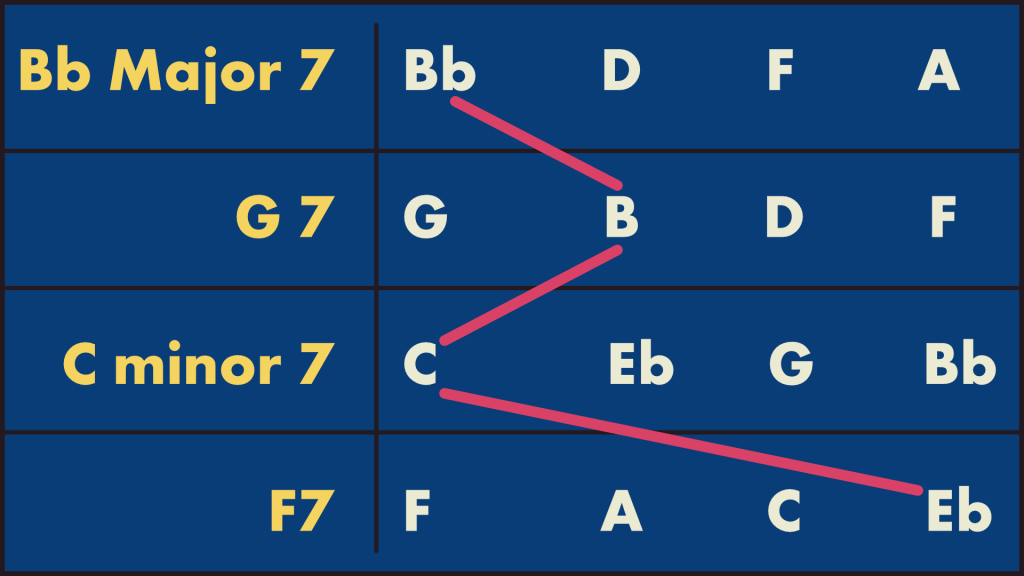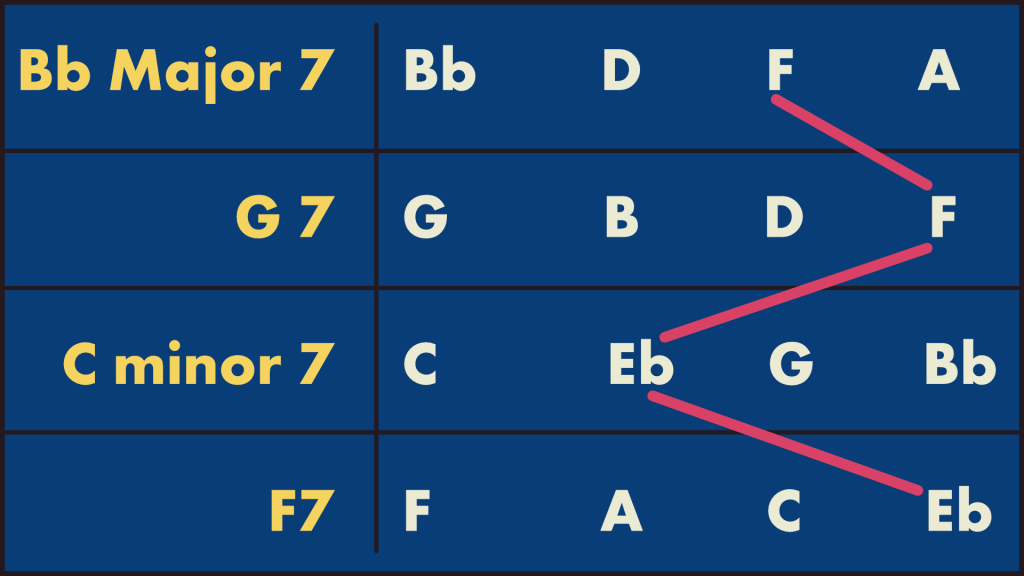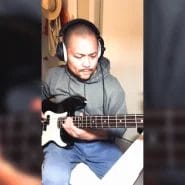In this jazz theory lesson we’re going to explore the cool concept of “Guide Tones.”
In jazz, these notes are key to the harmonic and melodic landscape of the music. Trust me, once you understand and use guide tones you’ll take your improvisations to a whole new level. And, you’ll experience a different level of freedom with your instrument. I promise.
Guide tones are the notes within a chord that define its character. Usually they’re the third and seventh (which carry the most harmonic weight and give the chord its unique sound) but can focus on other notes especially the inner voice movement within a chord progression. And that’s where it gets really cool.
Let’s dive in.
What Are Guide Tones?
Guide tones are the special notes within a chord that give it its flavor. They’re also the notes that lead from one chord to another in a chord progression, usually the 3rds and 7ths (these are sometimes referred to as essential guide tones).
But you can get some really cool melodic direction by focusing on the inner voices of a chord. Personally, I’m drawn to the sound when there’s step-wise motion going on within the chord tones of a chord progression. Some of my favorite jazz musicians often target step-wise inner voice movement when they navigate the chord changes.
Guide tones are the key to making melodies fit with the chords. They’re like road signs in music, telling us where to go harmonically and melodically. They help us make good choices when we improvise. And these choices naturally sound melodic.
Knowing guide tones, or even better, being able to hear guide tones, helps us know how chords connect and makes our music sound better.
It’s like having a map that can guide us through any jazz standard.

Why You Should Learn About Guide Tones
Learning to use guide tones in jazz improvisation has many benefits that will make you a better musician.
Here are a few:
- Harmonic Awareness: Guide tones give you a solid foundation to understand and navigate the chord progression. By focusing on these key tones you’ll develop harmonic awareness and make melodic choices that fit the chords being played.
- Melodic Clarity: Guide tones are musical landmarks that help you establish a clear target. When soloing over a chord progression you can use these notes as reference points to create melodic lines that connect and resolve within the harmony. This means smoother and more purposeful improvisation.
- More Melodic Variation: By playing different combinations and variations of guide tones you can create interesting melodic lines that add depth to your improvisation. Experimenting with rhythmic patterns, intervals and embellishments based on guide tones opens up a world of possibilities and helps you develop your unique voice.
- Seamless Voice Leading: Guide tones make voice leading between chords seamless. As you move from one chord to another emphasizing the movement of the guide tones provides a smooth connection between the harmonies. This makes your improvisation feel more cohesive and professional.
- Built-In Ear Training: By focusing on guide tones your ear can anticipate and respond to the chord changes being played by the other instruments. This gives you a strong musical connection and you can engage in dynamic and fun improvisational conversations with your fellow musicians.
- Melodic Direction: Your lines will always have direction. Any listener, even non-musicians, can tell where your lines are going.
Mastering guide tones in jazz improvisation empowers you to navigate harmonies with confidence, and create compelling melodies. It’s a valuable skill that opens up a world of musical possibilities and adds depth and sophistication to your playing.
Let’s take a look at how we can apply this in practice.
The Guide Tone Concept And How To Apply It To Your Solos
The concept of guide tones will work over ANY chord progression. It’ll work over a simple pop chord progression, complicated jazz harmony like Giant Steps, and even random chord progressions.
The reason why it always works, is that every chord progression (simple, complex, or random) will have inner voice movement.
Inner voice movement is when a chord tone of a chord is followed by another chord tone that’s close to it. The strongest inner voice movement will move in either whole-steps or half-steps.
The best way to understand this concept, is visually see a simple chord progression with the chord tones mapped out. From there, you can start to see chord tones that are whole-step or half-step apart. These chord tones will become the foundation for your melodic line—A.K.A. Your Guide Tones.
The visual below maps out the first few chords of Rhythm Changes, a popular standard set of chord changes in jazz.
Notice that there are 3 strong melodic directions that you can choose for your guide tones:
- Ascending: The guide tones ascend and continue to ascend.
- Descending: The guide tones descend and continue to ascend.
- Staying Put: The guide tones either share the same note for extended periods of time (also known as common tones) or have a mixture of ascending and descending with a very limited range.
The visuals below map out a few options for you.
Here are 4 simple steps for applying guide tones to create a melodic outline for your your solos:
- Decide on a chord progression. It can be a simple ii-v-i chord progression, or even something random. Tip: If you use 7th chords, you’ll have more options for your note choices.
- Map out the chord tones for each chord in the chord progression.
- Choose your direction (ascending, descending, or staying put).
- Connect your guide tones.
The visuals below map out a few options for you.
Note: The more you practice this concept, your ears will start unlock and you’ll be able to hear these guide tones without having to map them out. In my personal experience, I’ve found that singing these guide tones helps to internalize the sound.
Example 1: Descending Guide Tones
For a basic I, VI, ii, V chord progression in Bb, one possible inner voice movement you can focus on to create your guid tone line can be a descending line starting on the D (3rd of Bb Major 7). The 3rd and 7th are essential guide tones because they can quickly define the quality of the chord. So, you really can’t go wrong if you use them to outline the harmony within your lines. Just keep in mind, the 3rd or 7th are just options and it’s not a hard set rule that you have to use them.

Example 2: Ascending Guide Tones
Using the same chord progression as in the previous example, one possible ascending guide tone line can be created by focusing on the inner voice movement starting on the root note of the Bb major 7 (Bb).

Example 3: Staying Put Guide Tones
In this example, the guide tones focus on shared chord tones within the chord progression. This keeps your guide tone line within a limited range and can be useful for creating tension.

Today’s Quick Tip From Personal Experience
Here’s a personal tip for all beginner bass players that are learning to improvise. Start out by applying one guide tone per measure. Once you’re comfortable with the concept, move on to using two guide tones per measure.
Guide tones work best when only a few are being used as target notes. That way the sound of the chord can be implied and you’re not having to think too much when you’re playing.
What To Do After You’ve Mapped Out Your Guide Tones?
Now that you’ve mapped out your guide tones, you’ve got a solid framework for your lines.
It’s time to connect these tones.
There really isn’t any right or wrong way to connect these guide tones. You can use diatonic scale notes, chromatic notes, approach notes, or enclosures. As long as you’re connecting the guide tones, the listener’s ear will hear the direction of your melody.
Start out by playing melodies with basic quarter note rhythm, almost like a walking bass line. Once you’ve internalized the sound and placement of your guide tones, you can explore introducing more rhythmic phrases.
For an alternative approach to soloing beyond guide tones, check out my article on Triad Pairs.
Now It’s Your Turn
If you scratch the surface of guide tones you’ll get a powerful tool for your solos.
These notes will give you a deeper understanding of harmonic structure and allow you to create melodies that sit beautifully over the chords.
Remember, guide tones are musical signposts, guiding your melodic choices and making your improvisation harmonically sound. And the best part is you’ll navigate the changes with ease, connecting and resolving your ideas.
Now go! Go forth and use guide tones! Practice, listen, and enjoy the guide tone journey.
Happy shedding!
If guide tones opened up the harmony for you, explore my full Jazz Harmony & Shapes hub for more ways to hear movement, create direction, and solo with intention.
Frequently Asked Questions
What are guide tones in jazz?
Guide tones are the key notes in a chord—usually the 3rd and 7th—that define its character and show how one chord connects to the next. They act like musical signposts, helping your lines resolve and move with clear direction through a progression.
Why should improvisers practice guide tones?
Practicing guide tones builds strong harmonic awareness, smoother voice leading, and melodies that naturally “fit” the changes. Your solos start to sound intentional instead of random, and even non-musicians can feel where your lines are going.
How do I practice guide tones on bass?
Pick a simple chord progression (like a I–vi–ii–V or ii–V–I), map out the chord tones, then choose one inner voice (3rd, 7th, or another close tone) and follow it through the changes. Start with one guide tone per bar, then move to two per bar as you get comfortable.
Are guide tones only the 3rd and 7th?
The 3rd and 7th are often called “essential guide tones,” but any chord tone that creates stepwise inner movement between chords can function as a guide tone. Focusing on these inner voices is where the really interesting melodic direction shows up.
How do I connect guide tones in a melodic way?
Use diatonic scale notes, chromatic approaches, and enclosures between guide tones. As long as you clearly land on the target tones, your ear will hear strong direction, and the “in between” material can be as simple or as adventurous as you like.









